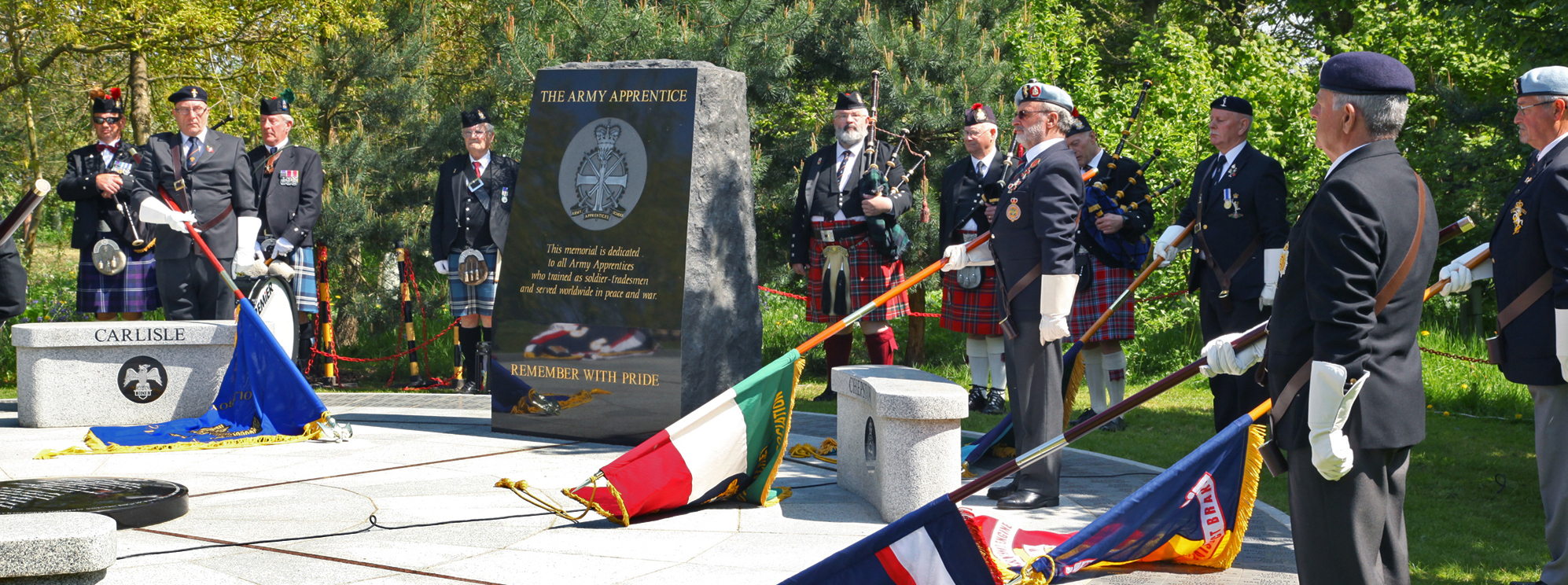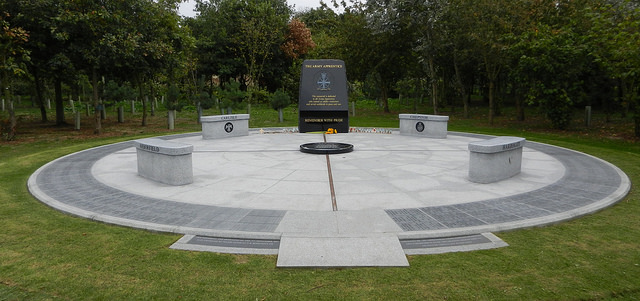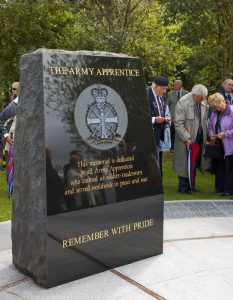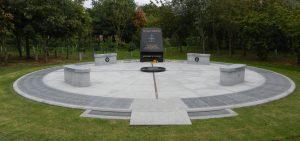Design factors of the Memorial
to embrace all former Army Apprentices
The most difficult factor to simplify during the initial design discussions was to identify a single icon that, as far as possible, would be an all-embracing paradigm easily recognised by the majority of ex -apprentices .
The icon chosen was the first Army Apprentice School badge with the King George the Sixth crown.
The Trustees were well aware that many apprentices were trained in various locations, and did not necessarily wear the Army Apprentice School badge as worn by a significant majority of apprentices who trained at the four colleges of Arborfield, Chepstow, Harrogate and Carlisle; an example among others, being the Royal Engineer Apprentices who trained at Fort Darland, Gillingham, Kent during 1939.
Ex-apprentices who trained at locations other than Arborfield, Chepstow, Harrogate and Carlisle, will appreciate the committee have tried to record on the memorial the location of each and every apprentice school/college/establishment where training was undertaken.
This dilemma was resolved when Commemorative Tablets were introduced. Each tablet is engraved with name, apprentice school/ college/ establishment, intake, and school/college years, thus recording a donation and record of service for all who wish to contribute through this scheme.
For example: Alfred Smith. Aldershot, 38A. 1938-1941
Specification
All parts of the memorial described below will be constructed in accordance with the National Association of Monumental Masons’ Code of Working Practice.
In outline, the memorial will consist of:
a. A circular base of light grey non-slip granite with a diameter of 7 metres made up of cut and fitted slabs.
b. At the centre of the base will be a dark grey polished circular granite slab with engraved text.
c. Four light grey granite benches placed and fixed on the granite base at the perimeter.
d. Around the perimeter of the base engraved commemorative stone tablets will be laid in two circular rings.
e. A rough hewn block of dark granite approximately 1.8 metre high by 1.2 metre wide by 0.6 metre thick and fixed at the perimeter of the base.
The Granite Base
a. The circular base of granite slabs will be laid on a reinforced concrete foundation
b. The concrete base will be further reinforced below the rough hewn granite block in order to support the weight of the monolith.
c. The base will be level with the surrounding area and the edge will present no trip hazard and will allow wheelchair access.
d. Four red lines marking out the quadrants pertaining to each of the four main apprentice schools. These will in actuality be set out with an infill of contrasting stone to the granite base panels.
e. Care will be taken to ensure the correct falls and drainage across the whole base area.
f. Every joint of the base will be hand pointed and sponged.
The Granite Centre Slab
a. The circular slab will be made of granite of similar colour as the main granite block at the perimeter.
b. The centre slab will have a diameter of 0.9 metre.
c. The centre slab upper surface will be slightly domed to assist with water run-off.
d. The centre of the slab will carry a suitable engraved text with silver lettering.
e. The upper perimeter edge will be raised 75mm above the granite base to obviate any tripping hazard
The Granite Benches
a. As per the drawing, the four benches will be manufactured with rounded edges to obviate any dangers from slipping etc.
b. The benches will be made from polished light grey granite similar to the circular base.
c. On the front and back of each seat the name of one of the four apprentice schools will be engraved.
d. On the seat of each bench the badge of the sponsoring old boys’ association will be engraved.
e. The four benches will be positioned around the base.
f. The four bench seats will be curved to mirror the perimeter of the circular base.
The Main Granite Block
a. The single granite block will have diamensions 1.8m x 1.2m x 0.6m.
b. The rear and sides of the block will be rough hewn.
c. The front of the block facing in to the circular base will carry the following:
- An engraved Army Apprentice School badge (Queen’s Crown) approximately 600mm high on a circular polished surface.
- Above the badge and in a size to ensure easy reading from the far edge of the memorial the words ‘THE ARMY APPRENTICE’ will be engraved
- Below the badge a suitable informative text will be engraved on a polished area
- At the base of the block, an engraved inscription such as ‘Remembered with Pride’
- At the foot of the block a suitable slot, approx 8mm wide by 1.2m long, will be placed to accommodate memorial tributes.
The Commemorative Tablets (Individuals)
a. Engraved commemorative Black granite tablets approx. 9″ x 6″ (225mm x 150mm) will be installed around the perimeter of the base, and will carry four lines of text: the name, school, intake and years as an apprentice.
b. The tablets will be laid in three rings, as required, to a maximum total of 575.
c. The tablets will be flush with the surrounding area and offer no trip hazard.
d. They were available to buy for £75 (£50 for families) but the scheme became fully subscribed by the 18th April 2011. They were also offered to all donors who contributed £75 or more, as a general donation.
e. It also offered the opportunity to be remembered, for those who served an Army trade Apprenticeship at other establishments.
f. The Buy a Tablet scheme has been the major fund raiser for the Memorial.
To acknowledge apprentice training locations, all known locations are listed within the Centre Slab in the floor layout:-
Aldershot, Arborfield, Ashvale, Bramley, Carlisle, Catterick, Chatham, Chepstow, Church Crookham, Deepcut, Harrogate, Hilsea, Jersey, Taunton, Woolwich and Worthy Down.



